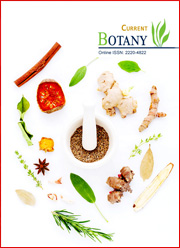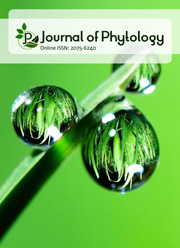Inhibitory effects of phytoextracts on mycelial growth and conidial germination of the Alternaria brassicae I-6A1y21 isolate causing leaf spot disease in mustard
DOI:
https://doi.org/10.25081/cb.2025.v16.9332Keywords:
Alternaria brassicae I-6A1y21 isolate, Inhibitory effects, Phytoextracts, Mycelial growth, Conidial germination, Leaf spot diseases, Mustard cropAbstract
The study of inhibitory effects of 13 plant extracts such as Lemon, Curry-leaf, Neem, Duranta, Ginger, Garlic, Parthenium, Cinnamon, Asparagus, Zamia, Lantana, Eucalyptus and Datura was taken to observe the effect on mycelial growth and conidial germination of Alternaria brassicae I-6A1y21 isolate. Among these plant extracts, only five plants extracts (Neem, Garlic, Lantana, Eucalyptus and Datura) were used in radial growth and ten plants extracts (Lemon, Curry-leaf, Neem, Duranta, Ginger, Garlic, Parthenium, Cinnamon, Asparagus and Zamia were used against conidial germination. Among the selected plants, the leaf extracts that showed maximum inhibition in mycelial growth was observed with Neem leaf extracts followed by Garlic, Eucalyptus, Datura and Lantana. The chemical Mancozeb fungicide was used at 0.2% level, which caused 100% inhibition in growth of selected isolate I-6A1y21 of A. brassicae. Other plant extracts inhibited the growth of test isolate which varied from 28.24% to 94.97% over control. The radial growth percent inhibition of treatments T3, T5, T4, T1, and T2 was 24.28, 35.45, 51.58, 79.29, and 94.97%, respectively, compared to the radial growth percent inhibition (100%) of treatment with 0.2% mancozeb (test treated, T6). Among the aqueous extracts of ten plants, the aqueous extracts of Azadirachta indica, Zingiber officinale, and Allium sativum were the substances that showed an inhibitory effect on the conidial germination of the A. brassicae I-6A1y21 isolate.
Downloads
References
Alotibi, F. O., Ashour, E. H., & Al-Basher, G. (2020). Evaluation of the antifungal activity of Rumex vesicarius L. and Ziziphus spina- christi (L) Desf. aqueous extracts and assessment of the morphological changes induced to certain myco-phytopathogens. Saudi Journal of Biological Sciences, 27(10), 2818-2828. https://doi.org/10.1016/j.sjbs.2020.06.051
Chattopadhyay, C. (2008). Management of diseases of rapeseed mustard with special reference to Indian conditions. In Sustainable Production of Oilseeds: Rapeseed Mustard Technology (pp. 364-388) Udaipur, India: Agrotech Publishing Academy.
DRMR. (2020-21). 28th Annual AIRCP (R&M) Group Meeting. Bharatpur, Rajasthan: ICAR-Directorate of Rapeseed-Mustard Research.
Ganie, S. A., Pant, V. R., Ghani, M. Y., Lone, A. H., Anjum, Q., & Razvi, S. M. (2013). In vitro evaluation of plant extracts against Alternaria brassicae (Berk.) Sacc. causing leaf spot of mustard and Fusarium oxysporum f. sp. lycopersici causing wilt of tomato. Scientific Research and Essays, 8(37), 1808-1811.
Guleria, S., & Kumar, A. (2009). Antifungal activity of Agave americana leaf extract against Alternaria brassicae, causal agent of Alternaria blight of Indian mustard (Brassica juncea). Archives of Phytopathology and Plant Protection, 42(4), 370-375. https://doi.org/10.1080/03235400601121380
Hayat, S., Cheng, Z., Ahmad, H., Ali, M., Chen, X., & Wang, M. (2016). Garlic, from remedy to stimulant: evaluation of antifungal potential reveals diversity in phytoalexin allicin content among garlic cultivars; allicin containing aqueous garlic extracts trigger antioxidants in cucumber. Frontiers in Plant Science, 7, 1235. https://doi.org/10.3389/fpls.2016.01235
Khalse, K. D., Lal, A. A., & Simon, S. (2017). Efficacy of bio-agents and plant extracts against the Alternaria leaf spot of cabbage (Alternaria brassicae). Journal of Pharmacognosy and Phytochemistry, 6(4), 1980-1982.
Kolte, S. J., Awasthi, R. P., & Vishwanath, V. (1987). Assessment of yield losses due to Alternaria blight in rapeseed and mustard. Indian Phytopathology, 40(20), 209-211.
Kumar, S., Prasad, S. M., & Kehri, H. K. (2024). Morphological and cultural variations of Alternaria brassicae isolates from mustard crop of Allahabad, Uttar Pradesh. Current Botany, 127-137. https://doi.org/10.25081/cb.2024.v15.8914
Prasad, P. V. V., Boote, K. J., & Allen Jr, L. H. (2006). Adverse high temperature effects on pollen viability, seed-set, seed yield and harvest index of grain-sorghum [Sorghum bicolor (L.) Moench] are more severe at elevated carbon dioxide due to higher tissue temperatures. Agricultural and Forest Meteorology, 139(3-4), 237-251. https://doi.org/10.1016/j.agrformet.2006.07.003
Sasode, R. S., Prakash, S., Gupta, A., Pandya, R. K., & Yadav, A. (2012). In vitro study of some plant extracts against Alternaria brassicae and Alternaria brassicicola. Journal of Phytology, 4(1), 44-46.
Tamayo, M. P. J., Becerra, V. D. C., & Jaramillo, N. J. E. (2001). Alternaria brassicae, causal agent of head rot in cauliflower (Brassica oleraceae L. var. botrytis L.). Ascolfi Informa, 27(2), 10-11.
Tewari, J. P. (1983). Celular alterations in the black spot of rapeseed caused by Alternaria brassicae. Plant Pathology, 73, 831.
Verma, P. R., & Saharan, G. S. (1994). Monograph on Alternaria Diseases of Crucifers. Saskatoon Research Centre Technical Bulletin, 1994-6E.
Wani, F. F., Wani, T. A., Shah, T. A., Ayoub, L., Amin, Z., Manzoor, T., Gull, A., & Bhat, T. A. (2022). Efcacy of diferent fungicides, plant extracts and bioagents against Phoma exigua causing Ascochyta blight of common bean (Phaseolus vulgaris L.). Indian Phytopathology, 75, 1191-1195. https://doi.org/10.1007/s42360-022-00546-0
Weiss, E. A. (1983). Oil seed crops. London, New York: Longman.
Yadav, M. S., Yadav, N. S., Yadava, D. K., Singh, S. K., & Mehta, N. (2023). Effect of bio intensive strategy on disease management in mustard (Brassica juncea). Indian Phytopathology, 76(2), 637-640. https://doi.org/10.1007/s42360-023-00611-2
Published
How to Cite
Issue
Section
Copyright (c) 2025 Shailendra Kumar, S. M. Prasad , H. K. Kehri

This work is licensed under a Creative Commons Attribution-NonCommercial 3.0 Unported License.



 .
.